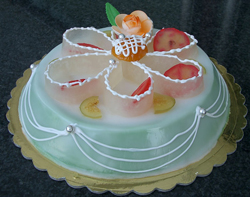Cassata
For people with the surname, see Cassata (surname).
 | |
| Alternative names | Cassata siciliana |
|---|---|
| Place of origin | Italy |
| Region or state | Sicily |
| Main ingredients | sponge cake, fruit juice or liqueur, ricotta, candied peel, marzipan, icing |
| Variations | Cassata a forno (in oven), cassata catanese |
Cassata or cassata siciliana (/kəˈsɑːtə/ kə-SAH-tə, Italian: [kasˈsaːta sitʃiˈljaːna], Sicilian: [kasˈsaːta sɪʃɪˈljaːna]) is a traditional sweet from Sicily, Italy.[1][2] Cassata consists of round sponge cake moistened with fruit juices or liqueur and layered with ricotta cheese and candied fruit, a filling also used with cannoli. Cassata has a shell of marzipan, pink and green coloured icing, and decorative designs. Cassata may also refer to a Neapolitan ice cream containing candied or dried fruit and nuts.
Origin
Cassata is believed to have originated in Palermo in the 10th century, when under Muslim rule.[3][4] The word al-qaššāṭī (القشاطي, Error: {{language with name/for}}: missing language tag or language name (help)) was first mentioned in Corleone in 1178.[5][6]
The Arabic word qas'ah,[Arabic text?] from which cassata may derive, refers to the bowl that is used to shape the cake.[7][8] Historian John Dickie claims instead that the Sicilian word cassata did not derive from Arabic qaššāṭah قشاطة, "bowl"), as is often claimed, but from Latin caseāta ("cheese concoction").[9] He observes that cassata did not signify a dessert until the late 17th century and did not take on its current striped form until the 18th century. Cassata, Dickie finds, "is the subject of an invented tradition based on the claim that its roots lie in the Muslim Middle Ages. Many other local food traditions purport to be as old."[10]
Variations

Unlike the round, traditional shape some cassata are made in the form of a rectangle, square, or box. The word "box" in Italian is cassa, although it is unlikely that the word cassata originated from this term.[citation needed]
Cassata Catanese, as it is often prepared in the Sicilian province of Catania, is made similar to a pie, containing a top and bottom crust, filled with ricotta, and baked in the oven.
The Cassatella di Sant'Agata (pl. cassatelle)—colloquially named Minni di Vergini, meaning "virgin breasts"—is a similar dessert, but made in a smaller, personal-serving size, with a candied cherry on top, and often a specifically green-coloured marzipan. It is typically made in Catania for the festival of Saint Agatha. The allusion to the female breast relates the specific torture Saint Agatha faced as a Catholic martyr.[citation needed]
When a cassata is made, layers of gelato (Italian ice cream) can be substituted for the layers of cheese, producing a dessert similar to an ice cream cake. The version of the recipe followed in Messina is less sweet than the one used in Palermo. "Cassata" can also refer to a flavor of ice-cream inspired by the sweet.
United States
In and around Northeast Ohio, particularly in the Cleveland area, the term "cassata cake" refers to a sponge cake soaked in syrup or rum, filled with strawberries and custard, and covered with sweetened whipped cream. This Cleveland version of the cassata first appeared in the early 1920s at LaPuma Spumoni & Bakery in Cleveland. The children of the owners did not like traditional cassata cake, made with sweetened ricotta, chocolate chips, and candied fruit. Using what he had in the bakery, Tomasso LaPuma created what was to become known as the Cleveland cassata cake. The fifth generation of this bakery, now located in the city's eastern suburb of Chesterland,[11] still continues to make the original version of this cake, as do many other Italian bakeries in the area.[12]
In Portland, Oregon cassata has come to mean a cake soaked with coffee liqueurs and espresso, due mainly to it being offered on the menu of only one establishment in the area. This version is made using Kahlua and espresso, with sweet ricotta and bittersweet chocolate shavings.[13] The variation differs from most recipes by having no fruit flavors or ingredients in the cake itself, and instead incorporating the more bitter coffee flavors the Pacific Northwest is known for, though it is usually served with a berry reduction.
India
In India, 'cassata' refers to a layered ice cream,[14] similar to Neapolitan ice cream, with three flavors, usually pistachio, vanilla, and strawberry, on a base of sponge cake, topped with chopped nuts.
See also
References
- ^ "Dai musulmani agli spagnoli: ecco le mutazioni della cassata siciliana". Cibodistrada.it. 2016-03-26. Retrieved 2016-10-22.
- ^ "Gastronomia". Web.tiscalinet.it. Retrieved 2016-10-22.
- ^ Habeeb Salloum (25 Jun 2013). Sweet Delights from a Thousand and One Nights: The Story of Traditional Arab Sweets (revised ed.). I.B.Tauris. pp. 139–40. ISBN 9780857733412.
- ^ Alan Davidson (11 Aug 2014). Jaine, Tom (ed.). The Oxford Companion to Food (illustrated ed.). Oxford University Press. p. 148. ISBN 9780199677337.
- ^ Alex Metcalfe (2009). The Muslims of Medieval Italy (illustrated ed.). Edinburgh University Press. p. 252. ISBN 9780748620081.
- ^ Alexander Metcalfe (21 Jan 2014). Muslims and Christians in Norman Sicily: Arabic-Speakers and the End of Islam. Routledge. p. 259. ISBN 9781317829256.
- ^ Vesna Maric (2008). Sicily. Ediz. Inglese (illustrated ed.). Lonely Planet. p. 45. ISBN 9781740599696.
- ^ Mary Taylor Simeti (2009). Sicilian Food: Recipes from Italy's Abundant Isle (illustrated ed.). Wakefield Press. p. 79. ISBN 9781862548503.
- ^ John Dickie, Delizia! The Epic History of Italians and Their Food (New York, 2008) p. 25.
- ^ Dickie 2008, p.30.
- ^ "La Puma Bakery - Cleveland Hot List". Cleveland.cityvoter.com. Retrieved 2016-10-22.
- ^ "Archived copy". Archived from the original on 2013-03-14. Retrieved 2013-03-28.
{{cite web}}: CS1 maint: archived copy as title (link) - ^ "Papa Haydn Desert Menu". Archived from the original on 2017-02-13. Retrieved 2017-02-12.
- ^ Murthy, Swineetha (2013-06-27). "Sakkarai Pandhal: Cassata Icecream". Sakkaraipandhal.blogspot.com. Retrieved 2016-10-22.
